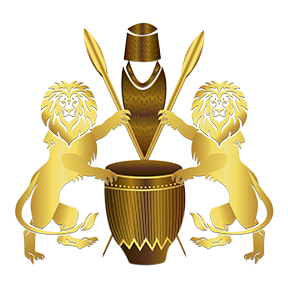Traditional Dances, Folk Tales & Songs
The Dances
Toro has two (2) types of cultural dances.
Amakondere Dance:
It’s a royal dance that is said to have originated from Bunyoro Kitara. It is performed when there is a function of the king, for instance, The Empango. It is a major activity meant to entertain the Omukama (King).
What does Amakondere mean? Where did the dance get its name? CONTENT NEEDED
It is performed by a dozen elderly men playing royal orchestra composed of a horn-shaped, wooden side-blown trumpet as the main instrument. This trumpet has its roots in a vegetable called ebyara, which belongs to the gourd and pumpkin family. They are long, hard-skinned, climbing plants that exclusively grow in various parts of Toro. Legend has it that ebyara made their way into Bunyoro then Toro from the neighbouring Democratic Republic of Congo.

To curve the Amakondere trumpets, the marrow of ebyara is removed to create a hollow structure. The trumpets which are cylindrical, with one end wider have a sooty tinge are of different lengths and sizes. To produce melody from the trumpets, the Abakondere (trumpeters) draw breath from the depth of their lungs and press their lips hard on the wood. Their costumes consist of bark-cloth, fastened in a knot over the right hand shoulder.
The Amakondere choreography involves dancing in twos, side by side. The dancers alternately lift one foot in forward motion. The mens arms are raised and positioned as if holding an invisible spear with a shield. The lips are mute while the orchestra rumbles. The women wear suuka while the men wear kanzus.
The Abakondere are selected from specific clans (which?) because blowing the Amakondere trumpets should not be done by anyone.
A rich fusion of tunes and pitches is derived as each trumpet supplies a single musical note accompanied by the reverberations of drums (empango).
“Amakondere garaire negaana” meaning the royal drums played till morning.
Amakondere is associated with jubilation. Dancing to the Amakondere is called “Okuguruka Amakondere”.
The Amakondere orchestra does not follow musical solfas. Instead, the tunes are derived mainly from folklore and praise the king.
Some of the orchestra tunes include “entale, kigambo kyomujwigaa”, which is translated as as, The King’s word is like a lion. When he roars, every soul has to fear.
While dancing to the Amakondere orchestra is open to everybody, it cannot be performed without royal permission.
Orunyege Dance:
It is performed at social ceremonies such as Empango, marriage, among other similar social gatherings of joy and jubilation.
The dance was named after the rattles (binyege / ebinyege) that are tied on boys’ legs to produce sounds and rhythms. The sound produced by rattles is more exciting as it is well syncopated as the main beat is displaced but everything blends with the song and drum rhythms.
| Omusaija ateera orunyege Omukazi azina enyamuziga Needs translation to English |
When dancing the orunyege dance, the ground crackles and reverberates with an unwavering mild tremor and the air tinkles with the sound of rattles firmly fitted to the feet of aggressive male dancers stomping to the pulsating rhythm of fervent drummers. The women, dressed in colourful costumes and sash reeds wrapped around their waists, stomp in gentler aggressive rhythm. Air rising, husky male voices meander through the drum rumblings and the nectar-sweet, feminine voices pitch in as if to mellow the uproar. The collective sum of the sound and sight is a compelling performance.
It is said to originate from a story when more than 10 men wanted to marry the same beautiful and good-looking girl. The parents organized a very big ceremony where all the male candidates were invited to come and dance. The girl had to choose the best male dancer. It was believed then that the best dancers always showed the best marriage life. It was also to see who the strongest among the men was as families in kinsmen did not want to give their beautiful girls to weak men, for when there was a period of drought or famine, one should have a husband who will really struggle to see that he looks for water and food. So in this dance the man who would get tired first, would lose first and that who would dance till the end would win the game, and the BRIDE.
This ceremonial dance therefore is also a courtship dance performed by the youth when it is time for them to choose partners for marriage.
NEED VIDEOS
The Folk Songs
NEED CONTENT, VIDEO & AUDIOS
Enanga
It’s a love song. Sang to praise the opposite sex
It is sang anytime but not at death
Ebizina by’ente
Used when making ghee, milking, grazing cows, when the cows are drinking water. Its sang by both sexes
Engoma Nyabahuma – sang when the mugole is being taken to the husband
Ebiremberro –lullaby
Ebyenimi – similar to ebizina ebyente
Ebikaso –
Ebizina Ebyembandwa
Kwebuga Engabo
The Folk Tales
NEED CONTENT
